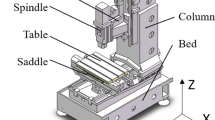Abstract
A dynamic performance analysis and optimization method of the horizontal machining center based on contact theory was presented in this paper. The contact stiffness models of ball screw joints and guide joints were proposed based on contact theory, and the predicted values are in good agreement with the experimental results. In particular, the prediction errors of the ball screw joints are within 2.8% compared with the 13 sets of experimental results of THK Company for 26 types. The analysis principle of dynamic performance was given by modal theory. With the goal of reducing the sum of modal flexibility and strengthening the weak modes, static flexibility analysis, modal flexibility analysis, and potential energy distribution analysis were carried out. By studying the effects of geometric parameters, material parameters, surface parameters, and assembly parameters on weak parts, the most effective parameters for optimization were determined. The sensitive parameters were improved from type selection, surface technology, assembly process, and structural improvement. The optimization results showed that the modal flexibility of the weak modes has been reduced by 51.80%, 38.44%, 46.58%, and 27.21%, respectively, the modal flexibility ratios have been reduced by 17.27%, 5.19%, 27.11%, and 2.45%, respectively, and the 1st, 3rd, 4th, and 7th natural frequencies of the horizontal machining center have increased by 26.64%, 11.38%, 4.14%, and 4.55%, respectively. The effects of various parameters on the horizontal machining center were also discussed, which can provide reference for further optimization and research.


















Similar content being viewed by others
References
Tlusty J, Ziegert JC, Ridgeway S (2000) A comparison of stiffness characteristics of serial and parallel machine tools. J Manuf Process 2(1):67–76
Yan R, Peng FY, Li B (2008) A method of general stiffness modeling for multi-axis machine tool. International Conference on Intelligent Robotics and Applications. Springer, In, pp 1013–1021
Huang DT-Y, Lee J-J (2001) On obtaining machine tool stiffness by CAE techniques. Int J Mach Tools Manuf 41(8):1149–1163
Balachandran B, Zhao MX (2000) A mechanics based model for study of dynamics of milling operations. Meccanica 35:89–109
Long X, Balachandran B (2010) Stability of up-milling and down-milling operations with variable spindle speed. J Vib Control 16:1151–1168
Čelič D, Boltežar M (2008) Identification of the dynamic properties of joints using frequency–response functions. J Sound Vib 317(1-2):158–174
Čelič D, Boltežar M (2009) The influence of the coordinate reduction on the identification of the joint dynamic properties. Mech Syst Signal Process 23(4):1260–1271
Mao KM, Li B, Wu J, Shao XY (2010) Stiffness influential factors-based dynamic modeling and its parameter identification method of fixed joints in machine tools. Int J Mach Tools Manuf 50(2):156–164
Mi L, Yin GF, Sun MN, Wang XH (2012) Effects of preloads on joints on dynamic stiffness of a whole machine tool structure. J Mech Sci Technol 26(2):495–508
Deng CY, Yin GF, Fang H, Meng ZYX (2015) Dynamic characteristics optimization for a whole vertical machining center based on the configuration of joint stiffness. Int J Adv Manuf Technol 76(5-8):1225–1242
Shi YG, Zhao XY, Zhang HJ, Nie YX, Zhang DW (2016) A new top-down design method for the stiffness of precision machine tools. Int J Adv Manuf Technol 83(9-12):1887–1904
Gao XM, Li BT, Hong J, Guo JK (2016) Stiffness modeling of machine tools based on machining space analysis. Int J Adv Manuf Technol 86(5-8):2093–2106
Jiang SY, Zhu SL (2010) Dynamic characteristic parameters of linear guideway joint with ball screw. Journal of Mech Eng 46(1):92–99
Zou CF, Zhang HJ, Lu D, Zhang J, Zhao WH (2017) Effect of the screw–nut joint stiffness on the position-dependent dynamics of a vertical ball screw feed system without counterweight. J Mech Eng Sci 232(15):2599–2609
Zhang J, Zhang HJ, Du C, Zhao WH (2016) Research on the dynamics of ball screw feed system with high acceleration. Int J Mach Tools Manuf 111:9–16
Majumdar A, Bhushan B (1991) Fractal model of elastic-plastic contact between rough surfaces. J Tribol 113(1):1–11
Zhang XL, Huang YM, Wen SH (2000) Fractal model of contact stiffness of joint surfaces. Transactions of the Chinese Society for Agricultural Machinery 31(4):89–91
Morag Y, Etsion I (2007) Resolving the contradiction of asperities plastic to elastic mode transition in current contact models of fractal rough surfaces. Wear 262(5-6):624–629
Miao XM, Huang XD (2014) A complete contact model of a fractal rough surface. Wear 309(1-2):146–151
Zhou AA, Chen TN, Wang XP, Xi YH (2015) Fractal contact spot and its application in the contact model of isotropic surfaces. J Appl Phys 118(16):165307
Jiang SY, Zheng YJ, Zhu H (2010) A contact stiffness model of machined plane joint based on fractal theory. J Tribol 132(1):011401
Yuan Y, Cheng Y, Liu K, Gan L (2017) A revised Majumdar and Bushan model of elastoplastic contact between rough surfaces. Appl Surf Sci 425:1138–1157
Zhang DY, Xia Y, Scarpa F, Hong J, Ma YH (2017) Interfacial contact stiffness of fractal rough surfaces. Sci Rep 7(1):12874
Chen HX, Yin Q, Dong GH, Xie LF, Yin GF (2019) Stiffness model of fixed joint considering self-affinity and elastoplasticity of asperities. Ind Lubr Tribol 72(1):128–135
Sun MN, Mi L, Gan J, Yin GF (2012) An optimum identification method of dynamic characteristic parameters of guideway joint on a NC machine tool. Adv Eng Sci 44(3):220–226
Funding
This research is supported by Sichuan University and Zigong Research Funds (2019CDZG-2) and the Department of Science and Technology of Sichuan Province (No. 2019ZDZX0021).
Author information
Authors and Affiliations
Corresponding author
Additional information
Publisher’s note
Springer Nature remains neutral with regard to jurisdictional claims in published maps and institutional affiliations.
Rights and permissions
About this article
Cite this article
Chen, H., Tan, Z., Tan, F. et al. Dynamic performance analysis and optimization method of the horizontal machining center based on contact theory. Int J Adv Manuf Technol 108, 3055–3073 (2020). https://doi.org/10.1007/s00170-020-05597-z
Received:
Accepted:
Published:
Issue Date:
DOI: https://doi.org/10.1007/s00170-020-05597-z




